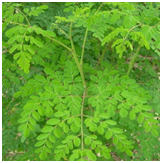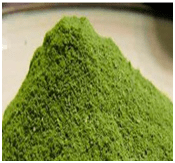Moringa oleifera is known as drumstick tree, the miracle tree, the ben oil tree, or the horseradish tree. In Hindi, Moringa is known as Sahjan. This is fast-growing tree and grown throughout the tropical regions. Moringa has been used for multipurposes such as human food (drumstick or pod for vegetable, leaves for vegetable), livestock forage, medicine values and water purification. It has wide adaptability and various health benefits. Moringa leaves contain a good amount of beta-carotene, protein, vitamin C, calcium, magnesium and iron. Moringa leaves are rich in protein, so it can be used as a feed supplement in poultry ration. Its leaves contain much higher protein than some conventional protein supplements like groundnut cake, coconut meal, cotton seed cake, sesame cake, sunflower cake etc. It is used as a natural feed supplement as well as an alternative to conventional feed supplements that can improve the performance and health status of poultry birds. Other parts of moringa rather than leaves can be used in poultry rations due to its nutritional values
Nutritional Profile of Moringa
Leaves: Moringa leaves contain fiber, fat, protein and minerals (Ca, Mg, P, K, Cu, Fe, and S). Vitamins like vitamin A (Beta-carotene), vitamin B-complex, nicotinic acid and ascorbic acid are present in the moringa leaves. Various amino acids like Arg, His, Lys, Trp, Phe, Thr, Leu, Met, Ile, Val are also present in it. Moringa leaves can be effectively used to fulfill the dietary and nutritional requirements of poultry. Moringa leaves powder/meal can be mixed with other feed ingredients during the formulation of feed for poultry birds.
Pod: It is rich in fiber, lipids, non-structural carbohydrates, protein and ash. Fatty acids like oleic acid, linoleic acid, palmitic acid and linolenic acid are also present. Moringa seed or pod and leaf extract have the antimicrobial properties which inhibit the growth of gram positive and gram negative bacteria. It has also the property of antioxidants which removes free radicals, activates antioxidant enzymes and inhibits oxidases, which results in better performance of birds.
Seed: It contains oleic acid (Ben oil), antibiotic called pterygospermin, and fatty acids like linoleic acid, linolenic acid, behenic acid, phytochemicals like tannins, saponin, phenolics, phytate, flavanoids, terpenoids and lectins. Apart from these, fats, fiber, proteins, minerals, vitamins like A, B, C and amino acids are present in moringa seeds.
| Nutrients (in 100g materials) | Fresh leaves | Dry leaves | Leaf powder | Pods |
| Calories (cal) | 92 | 329 | 205 | 26 |
| Protein (g) | 6.7 | 29.4 | 27.1 | 2.5 |
| Fat (g) | 1.7 | 5.2 | 2.3 | 0.1 |
| Carbohydrate (g) | 12.5 | 41.2 | 38.2 | 3.7 |
| Fibre (g) | 0.9 | 12.5 | 19.2 | 4.8 |
| Vitamin B1 (mg) | 0.06 | 2.02 | 2.64 | 0.05 |
| Vitamin B2 (mg) | 0.05 | 21.3 | 20.5 | 0.07 |
| Vitamin B3 (mg) | 0.8 | 7.6 | 8.2 | 0.2 |
| Vitamin C (mg) | 220 | 15.8 | 17.3 | 120 |
| Vitamin E (mg) | 448 | 10.8 | 113 | – |
| Calcium (mg) | 440 | 2185 | 2003 | 30 |
| Magnesium (mg) | 42 | 448 | 368 | 24 |
| Phosphorus (mg) | 70 | 252 | 204 | 110 |
| Potassium (mg) | 259 | 1236 | 1324 | 259 |
| Copper (mg) | 0.07 | 0.49 | 0.57 | 3.1 |
| Iron (mg) | 0.85 | 25.6 | 28.2 | 5.3 |
Preparation of Moringa Meal for Supplementation in Poultry Feed
Methods for the preparation of Moringa leaf powder/meal:
(a) Fresh, green and undamaged mature moringa leaves should be plucked. Tender moringa leaves have more nutrients. The collected leaves must be dried at 55°C till the moisture content of leaves to be 10% or less. After drying the leaves, it should be crushed to powder and sieved with 4 mm sieve/mesh.
(b) Collect fresh green and undamaged mature moringa leaves.
Dry leaves in air for five days and leaves become brittle.
Ground it into fine particles using a simple hammer mill.
Effect of moringa leaf meal on the laying performance of hens:
Moringa leaf meal has readily available protein, which is convenient for monogastric animals, and also has the higher levels of methionine and other essential amino acids. The inclusion of Moringa leaf meal in poultry feed may vary but it can be supplemented up to 6% in the diet of growing chicks and upto 10% Moringa leaf meal to the laying hen diet. It can substitute for sunflower seed meal and increase feed intake.
Egg production percentage decreased with an increase of Moringa leaf meal level. Feed conversion ratio (FCR) (kg feed/kg egg) increased when Moringa leaf meal was added beyond the inclusion level of the laying hen diet. An addition of 5% Moringa leaf meal increased egg weight due to high content of methinine in M. oleifera leaf. There is an increase in feed intake and feed conversion ratio, and decrease in egg mass production, egg production percentage, and egg weight at a higher level of Moringa oleifera leaf meal are mainly due to low digestibility of energy and protein.
Effect of moringa seeds on the performance of broilers:- Moringa oleifera undecorticated seed powder (MOUSP) supplementation @ 1% in the starter feed having negative effects on weight gain, final live body weight, feed efficiency and dressing percentage. Therefore, use of MOUSP at an amount of 1% during the finisher period overcomes its deleterious effect during the starter period. Therefore, it is better to use this level during the finisher period only.
The dietary supplementation with Moringa leaf powder up to 5% in broiler chicken improves feed conversion ratio and decreases the mortality rate. This supplementation at low rate also increases feed intake. Moringa oleifera in broiler feed helps to ameliorate bird health condition and reduces death incidence. This can be due to the rich nutrient profile of Moringa oleifera leaves. Actually, Moringa plants have growth promoter, antimicrobial and immunomodulatory properties. Excessive amount of Moringa leaf meal in poultry feed produces adverse effects and these adverse effects of high levels of leaf meal in poultry feed can be a result of low digestibility of the protein. Replacing Enrofloxacin with Moringa oleifera leaf meal (MOLM) reduces the cost of production of broilers.
Method of Moringa as Feed Supplementation in Poultry Feeding:
It is easier and the best method to incorporate the Moringa leaf in feed during the feed formulation for the poultry birds. Milling the leaf with the feed improves the digestibility, performance and growth of the birds. Moringa oleifera contains also some bioactive molecules which reduce the activity of pathogenic bacteria and also improves the digestibility of other foods. Moringa oleifera leaves are rich in minerals, vitamins and especially protein with eight essential amino acids. Thus, the improvement of chicken growth may be attributed to those essential nutrients contained in Moringa leaves. Moreover, the growth performance of chicks can be linked to the high digestibility of this leaf. Thus, birds fed with Moringa would have the beneficial effects of a reduced pH which inhibits pathogenic microflora growth in the digestive tract and improves gastric digestion.
It is concluded that Moringa leaf meal can be used at levels of up to 6% of the diet of growing layer chicks and up to 10% of the diet of laying hens. Up to 5% of Moringa leaf of the diet of broilers does not have deleterious effects on the performance of broilers. Regarding economic benefits, the levels of inclusion of Moringa leaf meal that can be expected to be cost-effective are 10% to replace fish meal in broilers’ diets, and finally upto 16% may be introduced in the diet of indigenous chickens or backyard poultry.

M. oleifera Plant 
M. oleifera Leaf Powder 
Feeding of Moringa leaves in poultry
Shashi Pal and Munish Sharma
Krishi Vigyan Kendra, S.A.S. Nagar (Mohali)